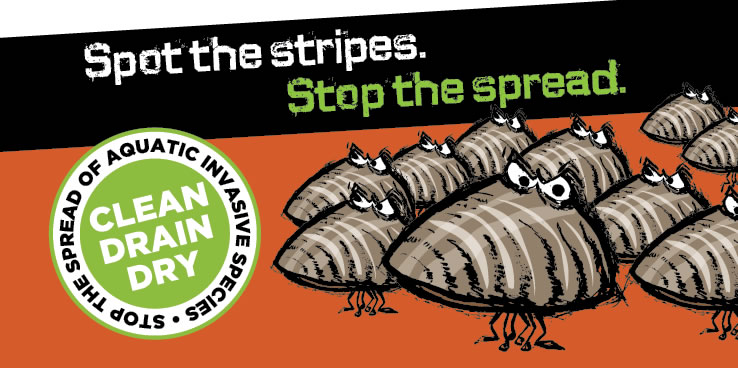
How to Stop the Spread
Adult zebra mussels attach to anything that sits in the water. This includes boats, canoes, trailers, float planes, buoys, fishing equipment, etc.. They can survive out of water for 7 to 30 days depending on temperature and humidity.
BOATERS AND FISHERS
Always clean, drain and dry your watercraft and equipment when leaving a lake or river. Drain or empty any standing water away from storm sewers, lakes and rivers.
CLEAN
- Remove all the visible AIS and aquatic plants.
- Then run your hands over any parts that were in the water. Recently settled zebra mussels feel like sandpaper. You may not be able to see them, but you'll be able to feel them.
- Check all parts of your watercraft, motor, anchors, recreational equipment such as fishing equipment and water skiing equipment.
Common places where zebra mussels are found on boats and trailers.

DRAIN
- all water
- pull drain plugs and open valves and/or operate pumps to remove water. For a detailed list, go to:
DRY
- Dry or decontaminate water-related equipment when leaving a water body.
- Any hard-to-drain areas or compartments of the watercraft should be dried with a towel.
- You can also leave water-related equipment and watercraft in the hot summer sun for at least five days.
- Leave live wells, bait buckets and storage compartment doors open to allow for drying.
Drying times increase greatly in the spring and fall due to increased humidity and lower temperatures. Three consecutive days of freezing at -10 °C or colder can also be used as a decontamination option.
DISPOSE
- Dispose of unwanted bait and worms in the trash, and dump bait bucket water on land.
- Bait, or the water in which they are held, may introduce diseases which can impact native fish and other aquatic life.
- Refer to the Manitoba Anglers' Guide for more information on bait use.
For a more complete list of what to clean, drain and dry, go to: https://www.gov.mb.ca/sd/waterstewardship/stopais/help/index.html
FLOAT PLANE OWNERS

Water-related aircraft such as float planes and water bombers can spread zebra mussels.
Follow these steps before taking off from a Manitoba water body.
- Clean and remove any noticeable zebra mussels or aquatic plants. Check floats, cables, rudders, and any ropes that are in contact or have been in contact with the water.
- Lay face-down on the pontoon and run hands along the pontoon at and below the waterline to thoroughly examine the entire pontoon surface underwater.
- The pontoons, unless treated with anti-fouling paint should be relatively smooth. Pay special attention to the surface of the pontoons. Zebra mussels prefer to hide in recessed and shadowed areas, such as around bolt heads. If the pontoons or water-related equipment feels like sandpaper, this could be small adult zebra mussels. The pontoons can be cleaned using decontamination methods, or removed with an appropriate plastic scraper or scrub brush.
- If water is drained from the float or pontoon of an aircraft, the water must be collected in a container and disposed on land so that it does not drain into a water body.

